Hello gentle readers, and welcome to a special Review Round-Up edition of SwitchArcade. So what is this? Well, while we enjoy doing Switch coverage and know many of our readers enjoy it, we also don’t want it to overwhelm our bread, butter, and bacon that is mobile gaming coverage. As such, we usually keep the Switch stuff to one post per day. Recently those articles have been getting bigger and bigger, and I’m having trouble finding places to stick Switch game reviews without making the SwitchArcade Round-Up prohibitively lengthy. To solve this problem, we will very occasionally be doing extra articles that focus completely on reviews. Not regularly, mind you. But when things get busy like they have lately, you may see this idea come back around. Without further ado, on to the reviews!
Brothers: A Tale of Two Sons ($14.99)
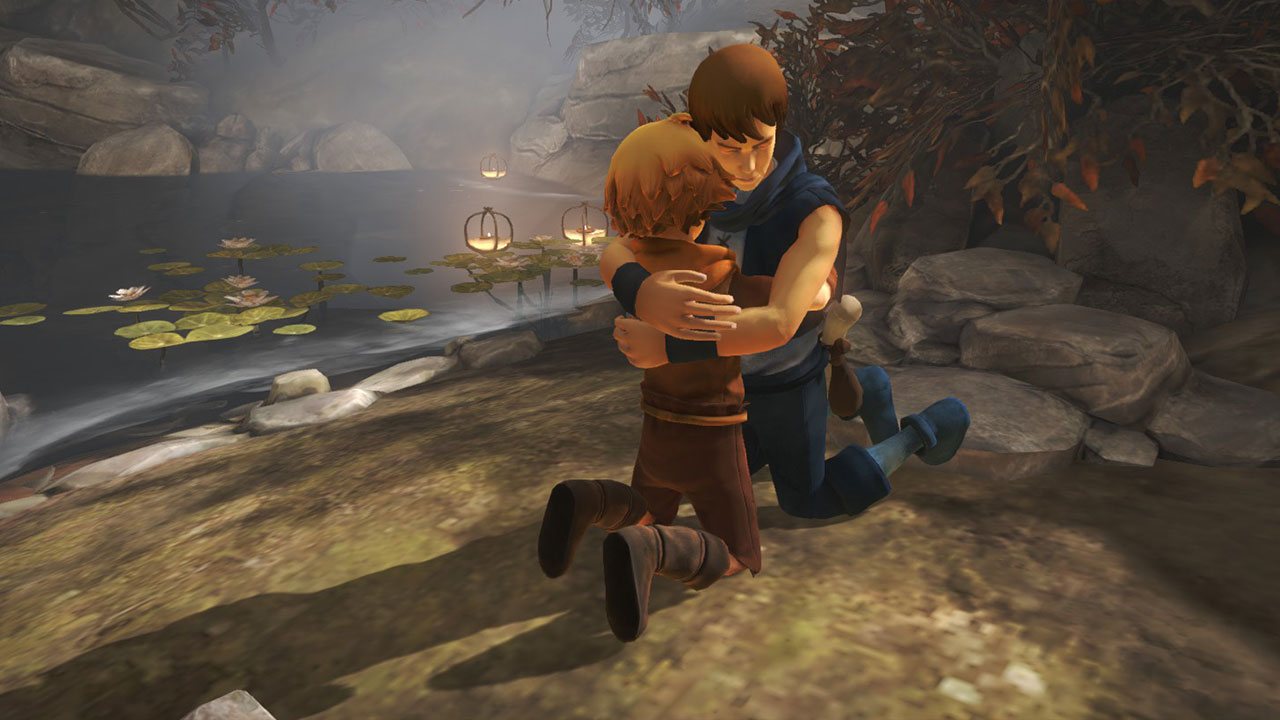
It’s been several years since the initial release of Brothers: A Tale of Two Sons, and I’ll lay it out straight: some of the shine has come off of the experience. The visuals aren’t as gorgeous as they once were. The player-friendly obstacles feel almost quaint given the current trend of hard-knock challenges. The innovative control set-up still feels unusual, but it manages to both lack satisfying depth and still be cumbersome. But the most important thing about Brothers has always been the story. Surely that is still fine? Well, it always had issues in my opinion, but in general, I think it works as well as it ever did.
This Switch version feels like it’s working off the bones of the mobile port, which isn’t necessarily a bad thing given the relatively good quality of that version. It has little hitches here and there and the polygon counts are a bit more obvious on bigger screens, but in general this looks and plays the way it ought to. The Switch has two sticks and the necessary shoulder buttons, allowing this version to preserve the original controls. You have to control both brothers, and each has their own stick and shoulder button assigned to them. Trying to move them both at the same time is as awkward as ever, but the game isn’t really too demanding most of the time so you can sort of muddle through it.
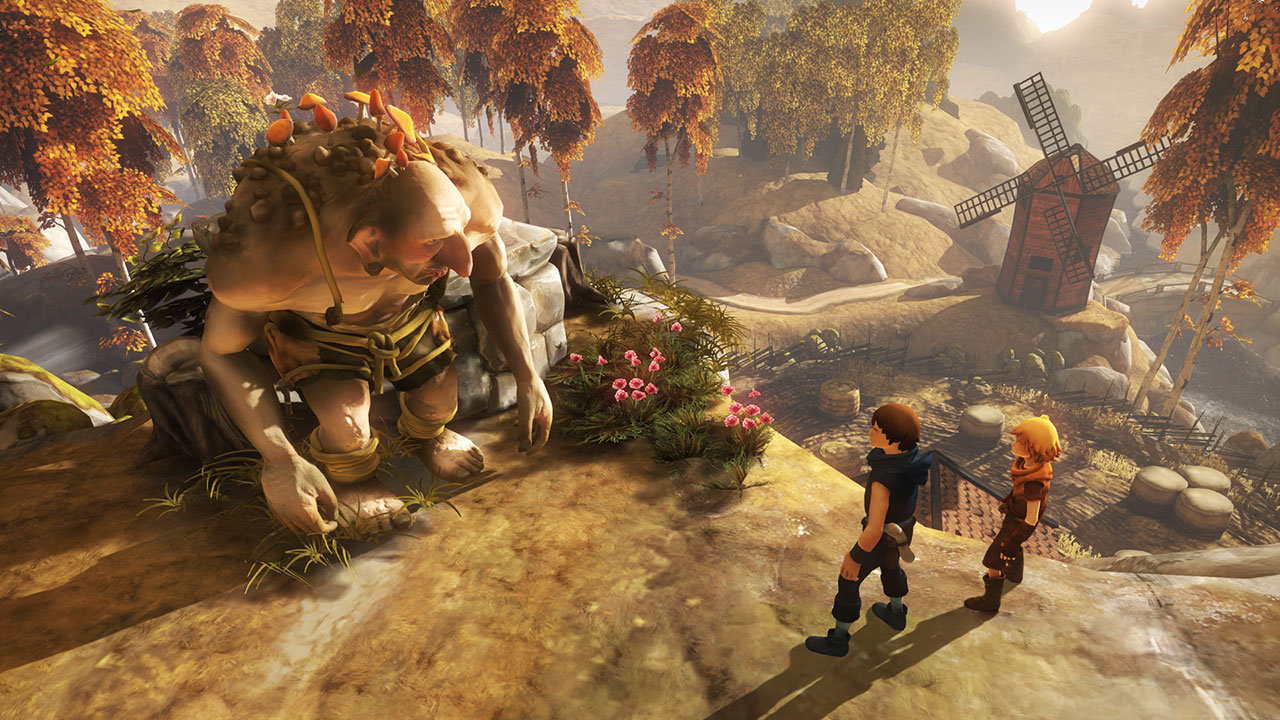
The story sees two brothers heading off on a journey to get some life-saving medicine for their dying father. The older brother is strong and confident, and he’s going to be the one to handle the heavy lifting for most of the journey. The younger brother, meanwhile, suffers from trauma thanks to watching his mother drown. He’s terrified of water, and generally lacks confidence in his own strength. That said, he’s also still a child and as such is a bit more playful than his sibling. The path to the medicine is quite treacherous and both of the boys will need to help each other to see it through. Mind you, the world isn’t exactly an open one. You’re mostly forced along a path and given a very limited number of objects to interact meaningfully with. Keep moving forward and hit that context-sensitive trigger regularly and you’ll get through.
When I reviewed the mobile version, I mentioned how I didn’t care for the ending, and I still don’t. But the journey itself is quite nice. Everyone speaks a made-up language, so you’ll have to glean what is going on from body language, the tone of voice, and the things going on around you. And if you choose to really engage with the world, you’ll be able to pick up a lot of things that help flesh out the world. The different ways the brothers interact with people and objects is interesting. The little details that you’re more or less stomping over on the way to your goal are fascinating. You’re following one tiny, little route in this world, but it does indeed feel like a world. It’s one of the best things about this game, and it’s something that few games properly handle to the level that Brothers does.
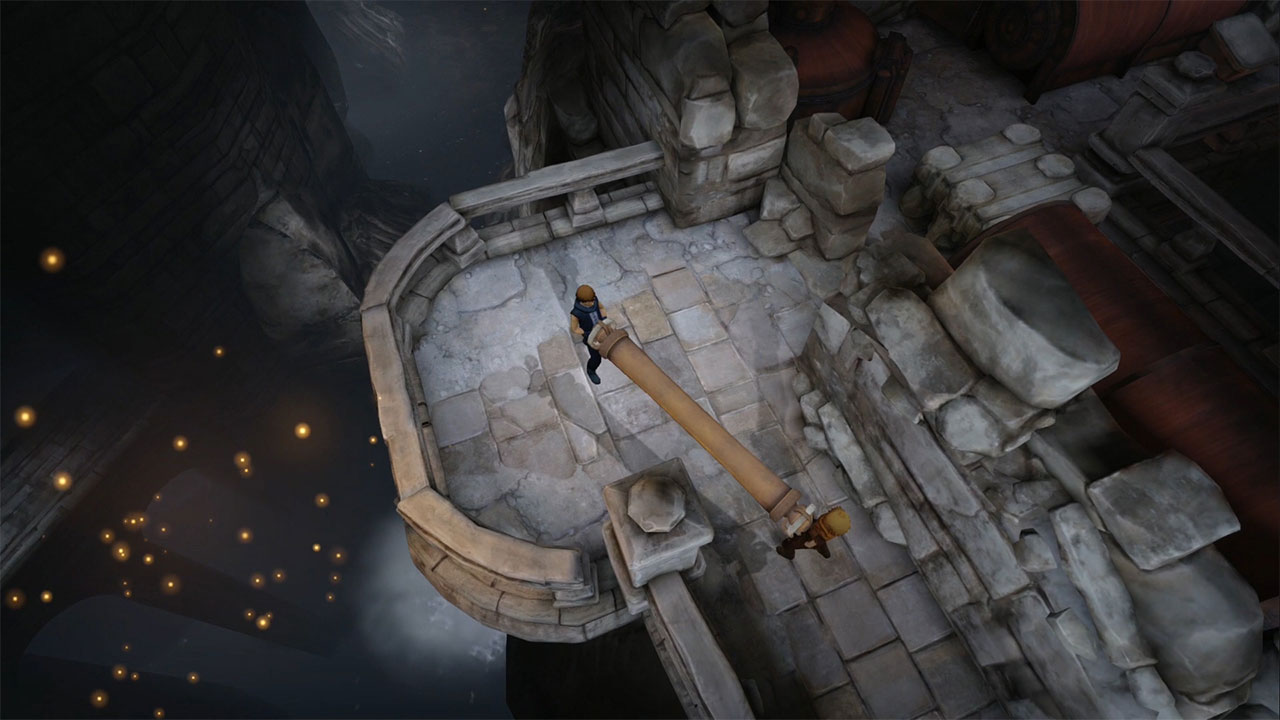
Ultimately, this is a relatively easy game that is more interesting in showing you its world and telling its tale than challenging you. The innovative control scheme certainly keeps things interesting early on, but in the long run you aren’t going to be here for the gameplay. If you’ve already played the game before, the main new thing added in the Switch version is a two-player co-op mode. It’s a different, albeit more conventional, way to play the game. But you’re still going to be seeing the same things and following the same story. If you haven’t played it before, you’re as good to play it here as anywhere. And yes, I think it’s still worth playing even if it’s not quite as impressive as it once was.
SwitchArcade Score: 4/5
Crystal Crisis ($29.99)
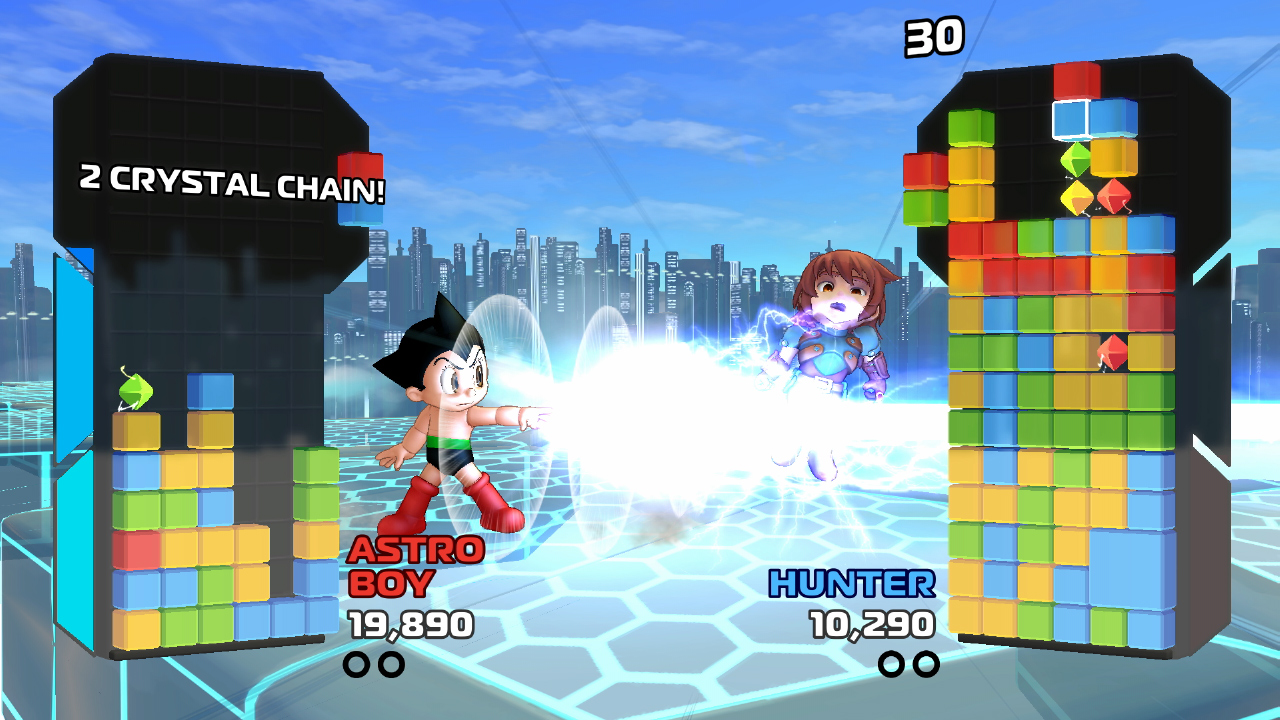
It’s been wonderful seeing head-to-head competitive puzzle games getting a bit of a resurgence lately. I feel like a good chunk of the 1990s leaned super-hard into this genre only to almost totally drop it in favor of more relaxed single-player matching games. But when done well, this type of game can be every bit as satisfying as a good fighting game. With Crystal Crisis, Nicalis has done it very well indeed. It’s a clear variant on Super Puzzle Fighter 2 Turbo, but with a style and feel all of its own. Really the best sort of homage, because I think it appeals nicely to fans of that classic while still having something to offer beyond it.
On the surface this is a big character mash-up, similar in idea to Blade Strangers, Nicalis’s take on the fighting genre. There’s quite the list of stars here all around, including some genuinely world-famous ones. You’ve got some characters from Nicalis-published games like Quote and Curly Brace from Cave Story, Isaac from Binding of Isaac, some of the characters from 1001 Spikes, and Solange from Code of Princess. Johnny Turbo, the extremely short-lived Turbografx pitchman, is also here for some reason. I guess he’s taking a break from putting out some of the worst-handled retro re-releases of the modern age. Astro Boy is here, part of a deal that sees both him and the slightly less-famous Dr. Blackjack join the game courtesy of Tezuka Productions. And the whole game is narrated by Peter Cullen, everyone’s favorite Canadian robot truck. He’s more or less just doing his Optimus voice. It’s good.
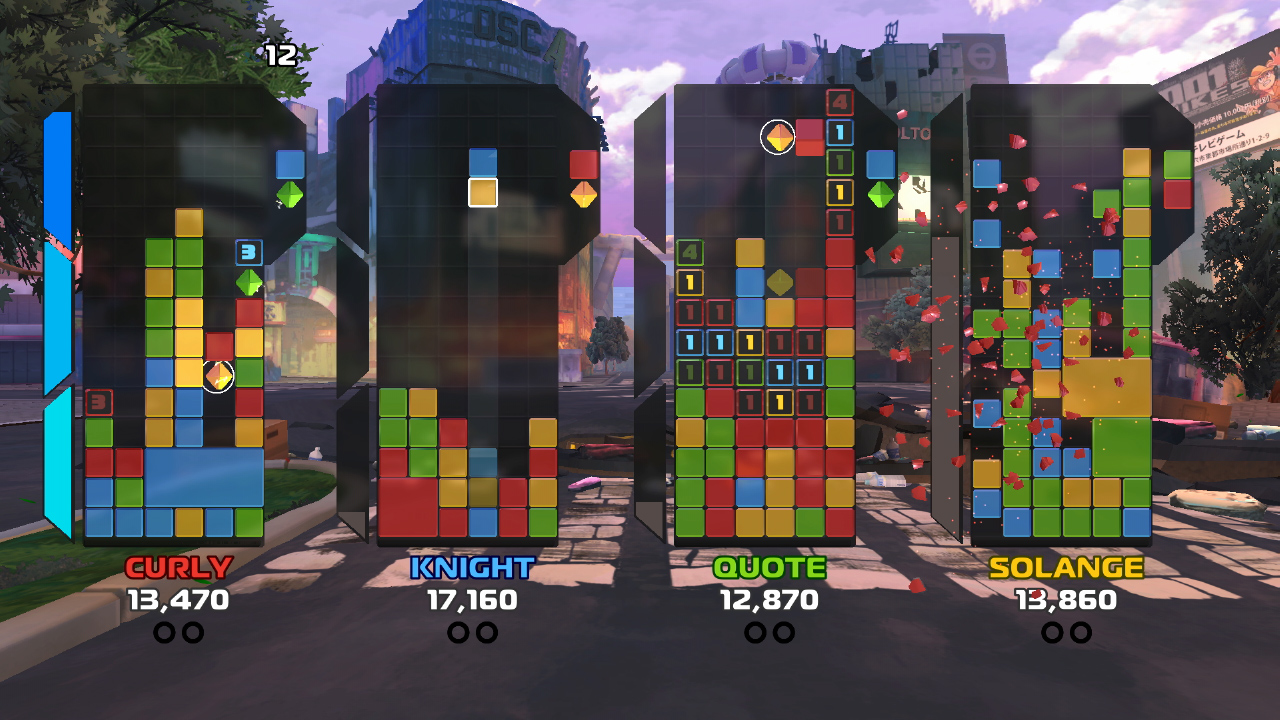
Anyway, this is a competitive falling block puzzle game. Blocks of different colors fall, and occasionally crystals of different colors are attached to them. If a crystal touches a block of a matching color, it will shatter all of the blocks of that color that are touching each other. Now that I think about it, describing a game like this in text is awkward. It’s like Puzzle Fighter. The proper one, not the free-to-play one. Ideally, you want to set up chain reactions to create combos, as that will dump a bunch of garbage blocks on your opponent’s field. The first person whose field is filled past the top with blocks loses. The difference here comes with the special moves. As you make matches, you’ll charge a meter. You can then activate one of two special moves that are unique to each character. Using these well will often be the difference between winning and losing. Besides the special moves, characters are also differentiated by the type of garbage blocks they drop.
You get quite a few different modes to mess around with. The Arcade Mode option on the menu allows you to play against a string of CPU opponents using the character of your choice. When you start, you can only access the standard mode, but you’ll eventually unlock a number of other rule sets including survival and tag team. There’s the Story Mode, which is where you will find the maximum amount of Peter Cullen voice. Here, you play a string of matches against the CPU, but the characters you can choose from is entirely dictated by the story. You’ll follow a branch and get your choice of two different characters. Depending on who you pick, you’ll then move down another branch where a different choice awaits. And so it goes until the end.
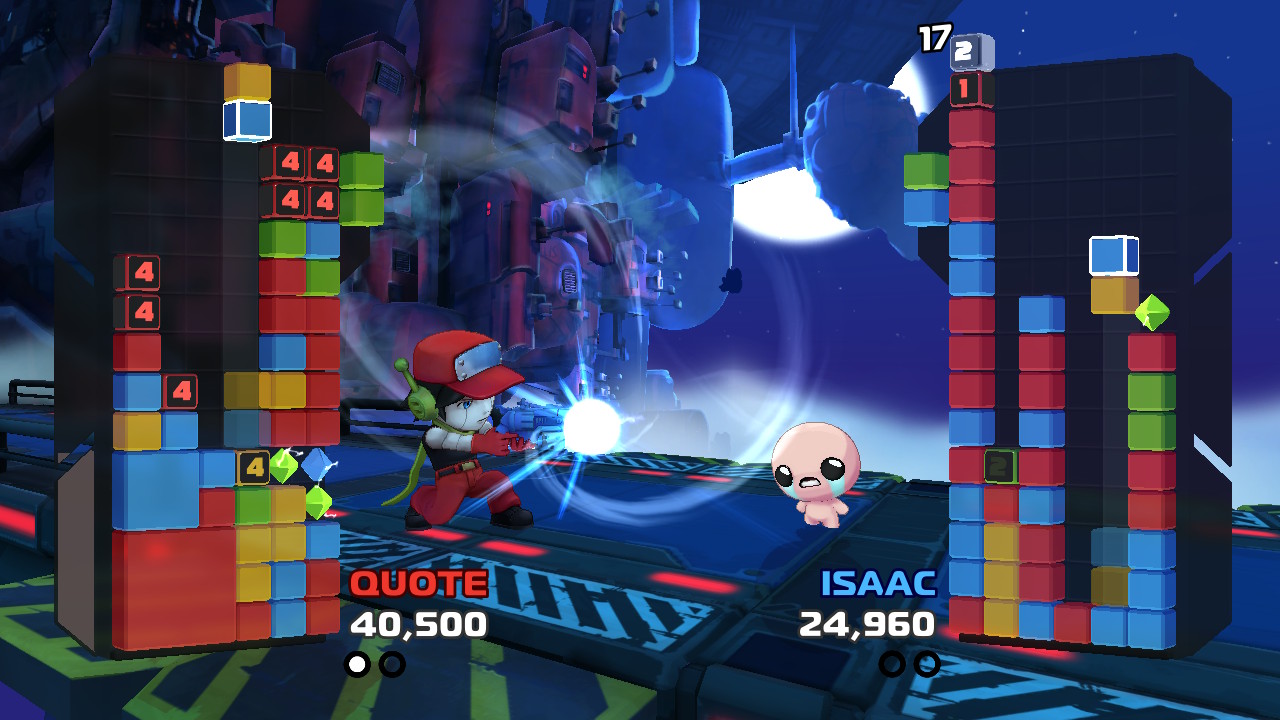
Of course, the longevity of the game is going to be in its multiplayer modes, and it does very nicely here. The Versus Mode lets you play locally with up to four players, with a number of the different rule sets from Arcade Mode available. Go Online allows you to play online in Ranked, Unranked, Custom, and Vs Friends modes. Finally, there’s also a Training Mode, an Extras menu with some cool art and a music player in it, and an Options menu where you can mess around with a number of the game’s settings. It’s hard to imagine what more you could ask for from a puzzle game in terms of gameplay modes, to be frank.
I’ve really been enjoying Crystal Crisis and I imagine I will be keeping it around on my Switch for a while. The single-player modes are reasonably enjoyable thanks to the attention paid to the production values, and the multiplayer modes are extensive in options and extremely fun. The presentation is excellent all around, and I appreciate that the developers were able to create such visual consistency between so many different kinds of characters. The actual mechanics may not the most original thing going in puzzle gaming, but it’s hard to argue with the results. If you’ve burnt out on Puyo Puyo Tetris, here’s your next thing.
SwitchArcade Score: 4/5
Lapis x Labyrinth ($29.99)
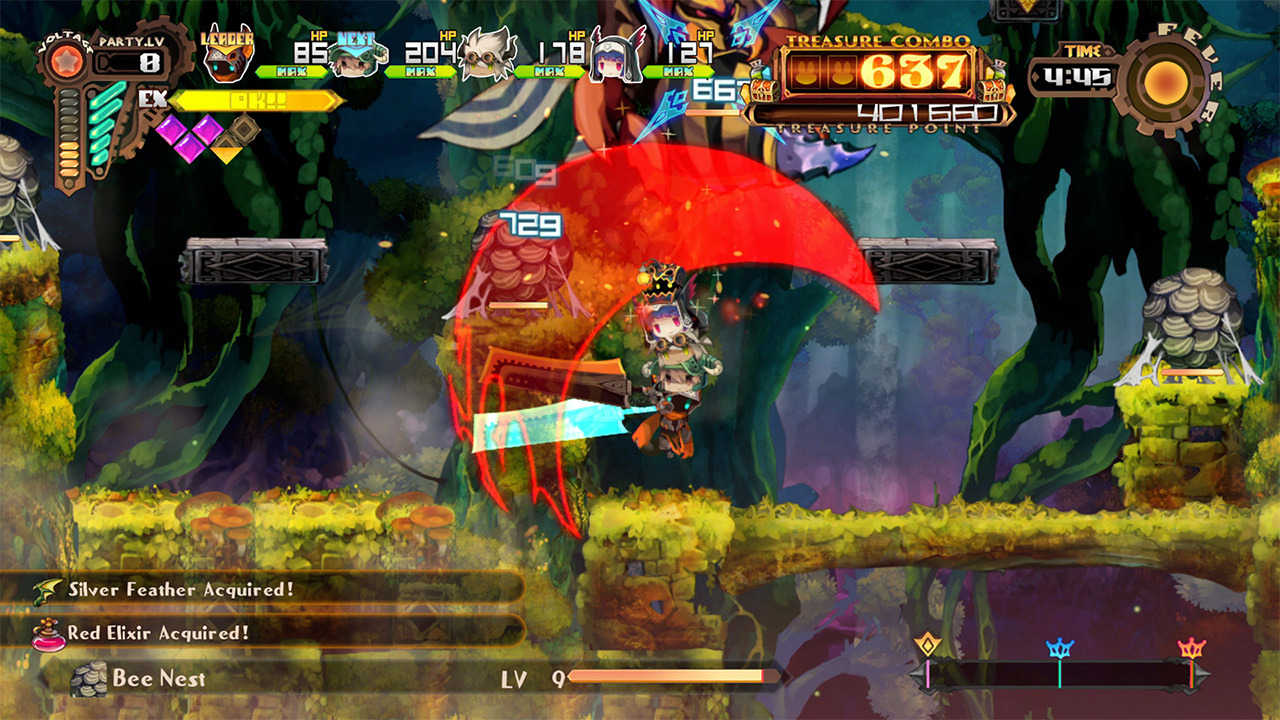
Games can scratch all kinds of itches. Sometimes you’re looking for a game you can really sink your teeth into. You want to lose a weekend, or curl up in the chair for the evening, or kill time on a very long flight. But sometimes, you just want some quick and dirty entertainment. That’s not usually an area where you find many RPGs, but that’s exactly where Lapis x Labyrinth lives. Well, it’s probably best to describe this as an action game with RPG elements and themes, but it’s definitely aimed at the sort of player looking for something fast and silly.
You start the game by picking a character from a bunch of conventional and less conventional classes. You then get a tutorial that teaches you most of what you need to know, in case you can’t figure out how to hammer the buttons on your own. Then the plight: a town near a labyrinth is in trouble. There aren’t many adventurers coming anymore, and for a town whose economy is based on buying from and selling things to adventurers, that spells financial ruin. So you have to, you know, do something about it. Take on quests. Go into the dungeon. Find lots of loot. Somehow this will help the town. I don’t remember how because the story really doesn’t impose itself on the game very often.
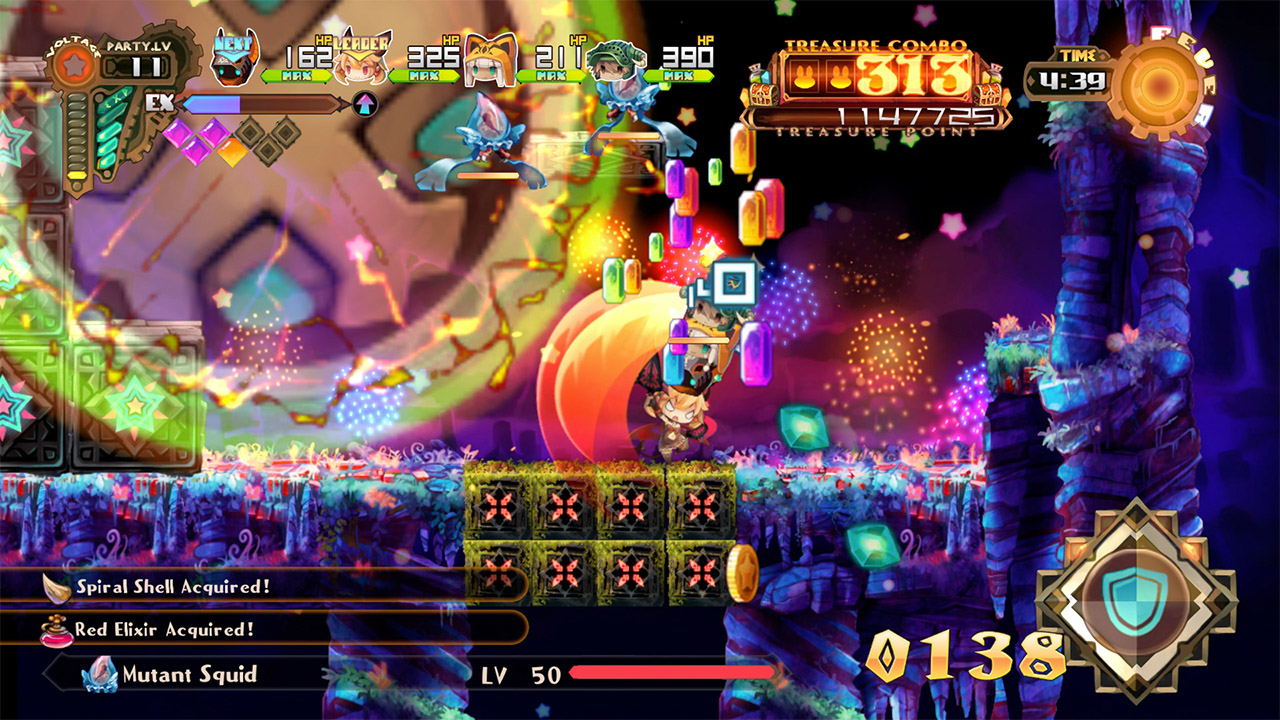
The main thing that jumps out at people with this game is the unique way your party is represented on-screen. You see, this is a side-scrolling action-RPG, and your party has up to four member in it. Sure, they could follow you around. That would make a lot of sense. But instead they stack up like a little chibi totem pole. It is adorable. You can swap between the active character at the tap of a button. Non-active characters can be pulled in for big team attacks. Otherwise it’s just a whole bunch of button-smashing, with combinations of buttons and directions pulling off different moves for each character. Fill up the Fever meter and you’ll go into a temporary invincibility where gems explode out of everything you whack. It’s ridiculous. And it’s very, very satisfying.
You’ll have loot lobbed at you liberally even normally, and it certainly makes the game feel a bit like a slot machine that never stops paying out. Levels are brisk and have limited exploration. No floor can take longer than five minutes, so it’s going to be a quick affair no matter what. And that kind of gets at the appeal of Lapis x Labyrinth. You grab a quest, get in, grab a bunch of loot, get out, equip some of that new loot, and repeat. Got a coffee break? Then you’ve got time to make meaningful progress in Lapis x Labyrinth while also having a good bit of fun. Where this starts to break down is if you settle in for a longer session. This game is as shallow as a roadside puddle, and while that’s probably not going to wear on you when you jump in for a quest or two now and then, it might start getting very repetitive if you try to take it on in larger doses.

I could easily see a person coming away from this game feeling like it was rather dull and pointless, but I personally quite enjoyed it. I took it little by little rather than shotgunning the whole thing in a few sessions, and in that capacity it was a rather nice diversion. It probably could have more substantial in a number of different ways, but I’m not sure that would have been possible without losing what it does fairly well in its present form. Lapis x Labyrinth isn’t an amazing game or anything, but if you want something to scratch that itch for cheap thrills, bright colors, pleasant sounds, and good old mindless action, you might find this serves the job well.
SwitchArcade Score: 3.5/5
Super Cane Magic Zero ($24.99)
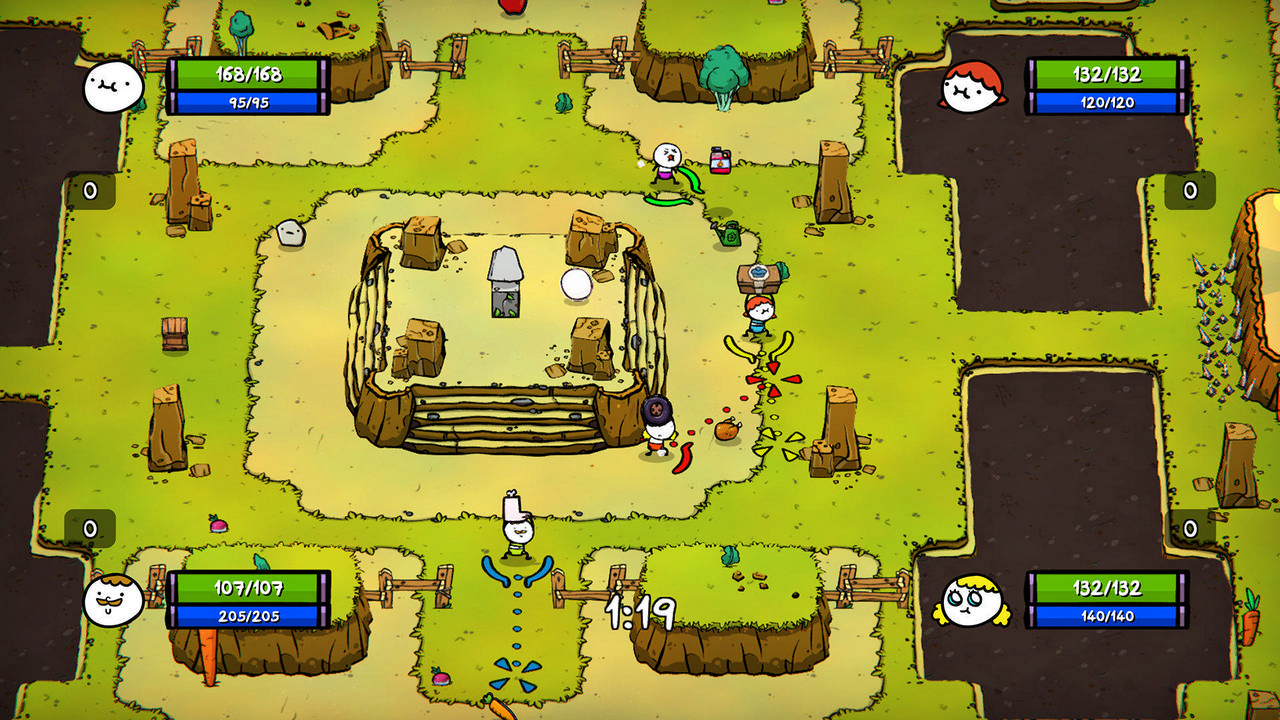
Trying really hard to be silly all the time in a piece of entertainment can be a risky move, and the longer you need to sustain it, the more difficult it becomes. The risk is that you’re going to overplay your hand or annoy people, and that’s certainly something that could happen with a game like Super Cane Magic Zero. This game’s narrative makes no sense, and it never tries to. Sometimes it’s funny, sometimes it’s not, but it’s never, ever serious. So if that’s what you’re looking for in an action-RPG, I can tell you right now that you’re going to have a bad time here.
The good news is that I think that’s probably the only way you would have a bad time with Super Cane Magic Zero. It’s a stage-based game where each level takes on the form of a rather large map that you can navigate with up to three other players. Each one is filled with loot, enemies, and some light puzzles. You’ll also find plenty of weird bosses along the way, too. The top-down action is a little awkward at times, but it generally works. I especially like how much emphasis there is on picking things up and throwing them. It sometimes feels like Super Mario Bros. 2 had an affair with The Legend of Zelda: A Link to the Past because of that aspect.

With the multiplayer option, wide variety of items, silly characters, and overall irreverent tone, it mostly reminds me of a variant on the old LucasArts trilogy that kicked off with Zombies Ate My Neighbors and ended with the underappreciated Herc’s Adventures. This game has a bit more in the way of RPG credentials than those, of course. You’ll have to navigate a skill tree when you level up, for example. But the feeling when playing it with others is quite familiar. That’s definitely a good thing.
It loses a bit of its shine when you’re playing alone, but it’s still worth playing even if you’re going solo. At the very least, no one will judge you if laugh at some of the stupider jokes. It takes about a dozen hours or so to blow through, and I could definitely see replaying it due to how generally breezy it is. But the game is definitely at its finest if you’re playing with others, and the more seats you can fill towards that goal, the more fun you’ll have. Sadly, there’s no online play here. You’ll need the appropriate amount of controllers and humans to take full advantage of the multiplayer.
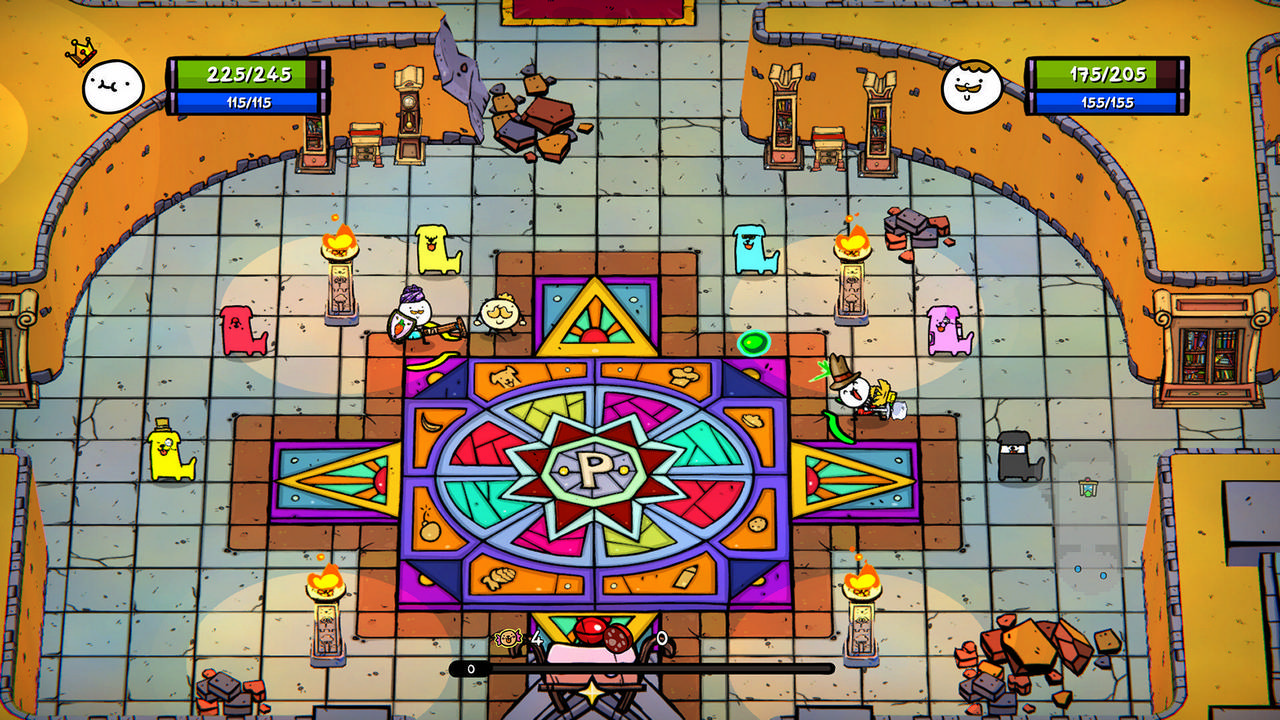
The game mostly comes out fine on the Switch, but I did run into the occasional hitch at seemingly random moments. The loading times are pretty long, but I’d imagine most Switch players are getting used to that by now. While I doubt Super Cane Magic Zero will be taking the place of Diablo 3 anytime soon for most people, it’s a really enjoyable off-the-wall take on the action-RPG genre that holds a lot of appeal to people who want something on the lighter side of the genre. Definitely worth picking up if you have friends to play it with, and something that you may want to consider even if you don’t.
SwitchArcade Score 4/5
PixARK ($39.99)
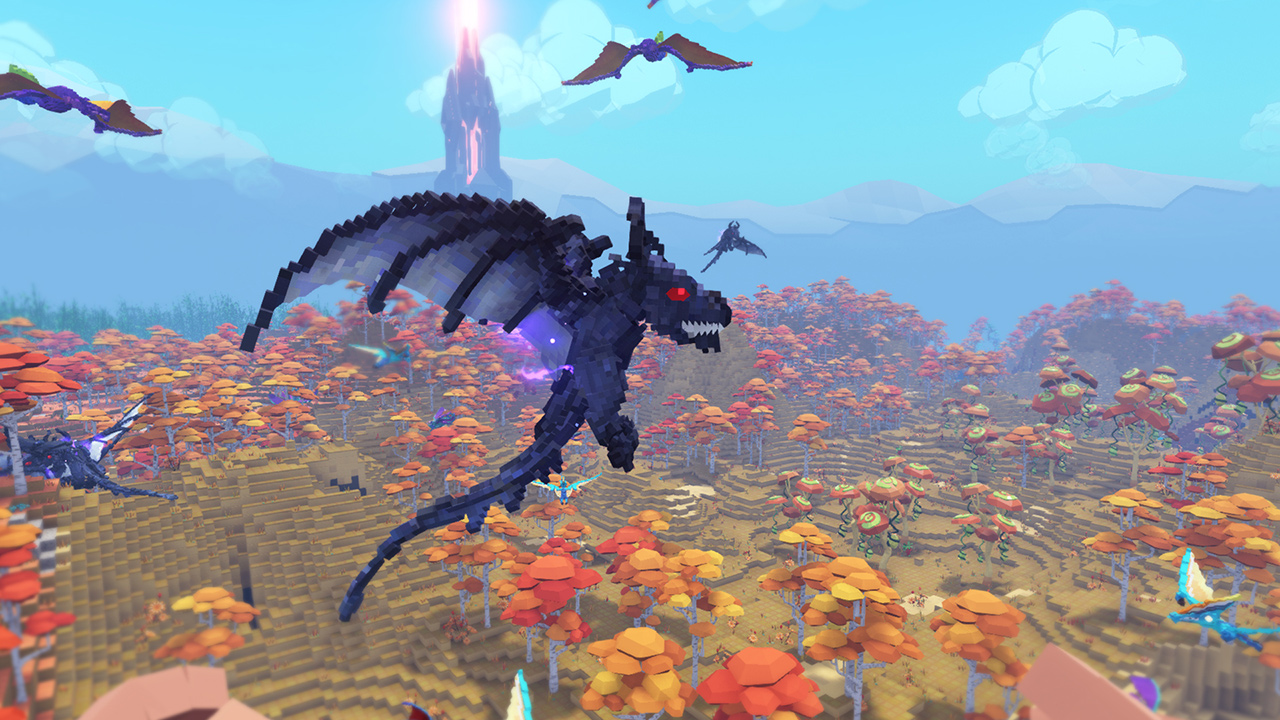
PixARK is the second appearance of the ARK brand on the Switch, and at the very least I can say that this one turned out a bit better than ARK: Survival Evolved. Though not bereft of technical issues, it’s considerably more playable. On the other hand, there are a few big non-technical problems with this version of the game. And then there’s the matter of the base game itself, an experience that has quite a few flaws of its own. It adds up to a game that’s pretty hard to recommend even if you could conceivably glean some enjoyment from it.
The napkin pitch of PixARK is ARK: Survival Evolved meets Minecraft. Like the former, it’s a prehistoric game of survival where you can befriend and ride dinosaurs and battle huge creatures. Like the latter, it’s a cube-based game where you can harvest and gather basically everything you see in order to build whatever you want. As mash-ups go, it’s quite a frictionless one. After all, Minecraft itself offers some light survival elements, and a survival game with crafting is just a hop, skip, and a jump away from having full-on building features.

Anyway, you start off by making your character. There are a satisfying number of options here, allowing you tailor your look. You’re then dropped into a procedurally-generated world, and depending on how lucky you are, you might not instantly get torn apart by a giant monster or dinosaur. Like Minecraft, you’re given almost no guidance. Unlike Minecraft, you’ve got a lot of extra things to worry about here. Food, water, and having a comfortable ambient temperature are all quite important, so you need to figure out how to secure those things first. You also need to figure out the controls, and the game is off and on about helping you out with that.
From here, you probably know how it goes for the most part. There are some differences from other building games, like the ability to befriend, ride, and level-up pets. They’ll help you in battle and if you’re playing by yourself you are doing to need to take heavy advantage of them. When you level up, you’ll need to assign points to your stats and to a skill tree that allows you to craft new things. What you are able to build is strictly gated by your level, which is quite different from Minecraft. There are quests to pick up and clear, though it’s a bit hard to figure out how to get at them early on.
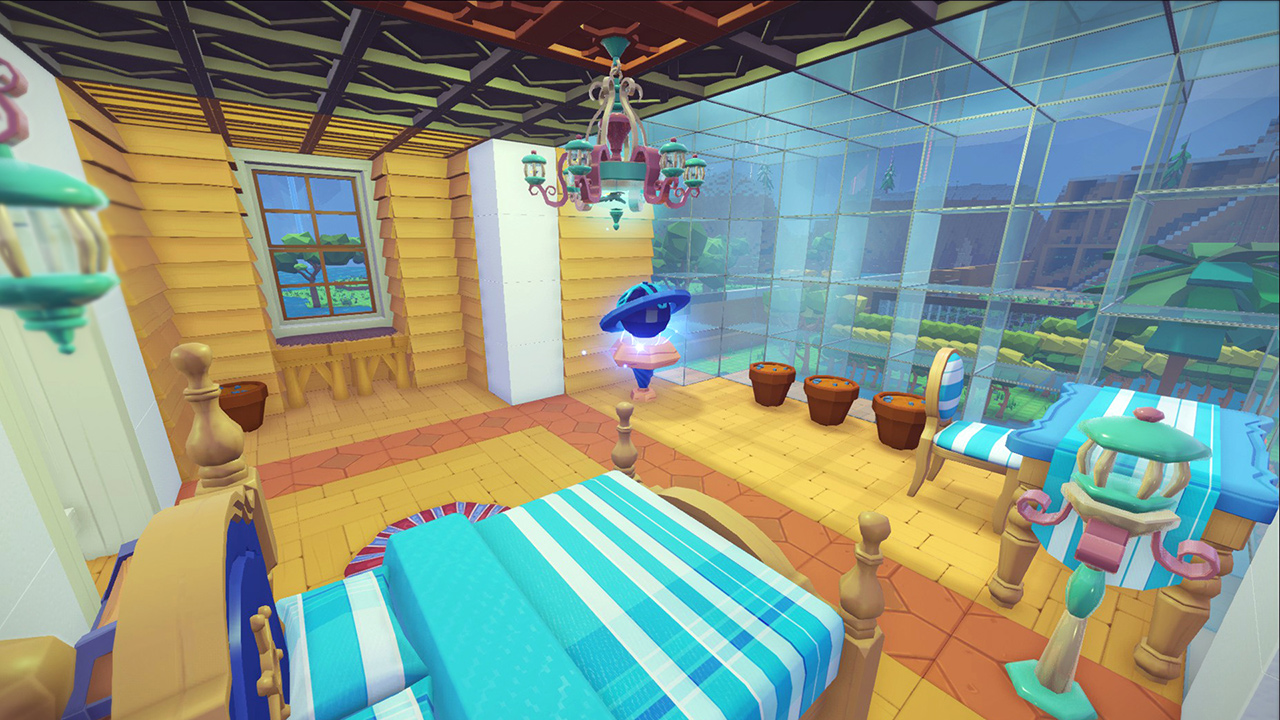
From a technical standpoint, the framerate sometimes acts up but is generally more well-behaved than it was in ARK. The constantly adjusting resolution makes a return appearance here, but it’s not quite as distracting, perhaps due to the simpler art style. Loading times are lengthy, and that’s an issue if you’re dying a lot. On the whole, it holds together a lot better than its predecessor, but compared to other building games on the system it’s trying to do more and failing a lot harder at it. I should also mention the absolutely dreadful UI, which is pretty clearly dragged over directly from a mouse-and-keyboard platform to a dpad-buttons-and-maybe-touch one. If you’re playing undocked, you can use the touch screen to alleviate some of the issues of the difficult-to-navigate menu, but you’ll have to deal with the tiny on-screen buttons. It’s just a very awkward game to play on the Switch no matter how you go about it.
As I alluded to earlier, it’s very easy to get rocked by a bad spawn in PixARK. Almost everything can kill you in the beginning, and you might find yourself confined to the tiniest of spaces because stepping outside of it in any direction will lead to death. You will get stronger, of course, but it takes time. And if you get stuck with a bad location, that time could be very dull indeed. You can solve a lot of these problems by hopping online and playing with others, but that would require others to be playing, which frankly is no guarantee with Switch Online games these days, and it would require them not to be total jerks that are just going to kill you and steal all your stuff. Which, again, good luck with that.

If you can push through the early slog or join up with some like-minded people and form a tribe, the game does eventually get a lot better. But it’s an awful lot of resistance to suffer in order to eventually end up at something about as fun as Minecraft. Add in the technical problems, the terrible UI, and the fact that this is somehow more expensive than Minecraft on the Switch, and you’ve got a game that has very narrow appeal. If you’ve run the game this apes into the ground and are looking for something almost like it but not quite, this may be something you’re interested in. It’s probably better on every other platform it’s been released on, mind you, but it’s playable here, and that’s more than we can say for ARK.
SwitchArcade Score: 3/5
Phew. That’s the lot, friends. Now that we’ve caught up on those reviews, we surely will not fall behind again anytime soon. Ha… ha ha! Anyway, I’ve got to get to writing the usual article, so I’ll leave you all here. As always, thanks for reading!
Brothers: A Tale of Two Sons ($14.99)

It’s been several years since the initial release of Brothers: A Tale of Two Sons, and I’ll lay it out straight: some of the shine has come off of the experience. The visuals aren’t as gorgeous as they once were. The player-friendly obstacles feel almost quaint given the current trend of hard-knock challenges. The innovative control set-up still feels unusual, but it manages to both lack satisfying depth and still be cumbersome. But the most important thing about Brothers has always been the story. Surely that is still fine? Well, it always had issues in my opinion, but in general, I think it works as well as it ever did.
This Switch version feels like it’s working off the bones of the mobile port, which isn’t necessarily a bad thing given the relatively good quality of that version. It has little hitches here and there and the polygon counts are a bit more obvious on bigger screens, but in general this looks and plays the way it ought to. The Switch has two sticks and the necessary shoulder buttons, allowing this version to preserve the original controls. You have to control both brothers, and each has their own stick and shoulder button assigned to them. Trying to move them both at the same time is as awkward as ever, but the game isn’t really too demanding most of the time so you can sort of muddle through it.

The story sees two brothers heading off on a journey to get some life-saving medicine for their dying father. The older brother is strong and confident, and he’s going to be the one to handle the heavy lifting for most of the journey. The younger brother, meanwhile, suffers from trauma thanks to watching his mother drown. He’s terrified of water, and generally lacks confidence in his own strength. That said, he’s also still a child and as such is a bit more playful than his sibling. The path to the medicine is quite treacherous and both of the boys will need to help each other to see it through. Mind you, the world isn’t exactly an open one. You’re mostly forced along a path and given a very limited number of objects to interact meaningfully with. Keep moving forward and hit that context-sensitive trigger regularly and you’ll get through.
When I reviewed the mobile version, I mentioned how I didn’t care for the ending, and I still don’t. But the journey itself is quite nice. Everyone speaks a made-up language, so you’ll have to glean what is going on from body language, the tone of voice, and the things going on around you. And if you choose to really engage with the world, you’ll be able to pick up a lot of things that help flesh out the world. The different ways the brothers interact with people and objects is interesting. The little details that you’re more or less stomping over on the way to your goal are fascinating. You’re following one tiny, little route in this world, but it does indeed feel like a world. It’s one of the best things about this game, and it’s something that few games properly handle to the level that Brothers does.

Ultimately, this is a relatively easy game that is more interesting in showing you its world and telling its tale than challenging you. The innovative control scheme certainly keeps things interesting early on, but in the long run you aren’t going to be here for the gameplay. If you’ve already played the game before, the main new thing added in the Switch version is a two-player co-op mode. It’s a different, albeit more conventional, way to play the game. But you’re still going to be seeing the same things and following the same story. If you haven’t played it before, you’re as good to play it here as anywhere. And yes, I think it’s still worth playing even if it’s not quite as impressive as it once was.
SwitchArcade Score: 4/5
Crystal Crisis ($29.99)

It’s been wonderful seeing head-to-head competitive puzzle games getting a bit of a resurgence lately. I feel like a good chunk of the 1990s leaned super-hard into this genre only to almost totally drop it in favor of more relaxed single-player matching games. But when done well, this type of game can be every bit as satisfying as a good fighting game. With Crystal Crisis, Nicalis has done it very well indeed. It’s a clear variant on Super Puzzle Fighter 2 Turbo, but with a style and feel all of its own. Really the best sort of homage, because I think it appeals nicely to fans of that classic while still having something to offer beyond it.
On the surface this is a big character mash-up, similar in idea to Blade Strangers, Nicalis’s take on the fighting genre. There’s quite the list of stars here all around, including some genuinely world-famous ones. You’ve got some characters from Nicalis-published games like Quote and Curly Brace from Cave Story, Isaac from Binding of Isaac, some of the characters from 1001 Spikes, and Solange from Code of Princess. Johnny Turbo, the extremely short-lived Turbografx pitchman, is also here for some reason. I guess he’s taking a break from putting out some of the worst-handled retro re-releases of the modern age. Astro Boy is here, part of a deal that sees both him and the slightly less-famous Dr. Blackjack join the game courtesy of Tezuka Productions. And the whole game is narrated by Peter Cullen, everyone’s favorite Canadian robot truck. He’s more or less just doing his Optimus voice. It’s good.

Anyway, this is a competitive falling block puzzle game. Blocks of different colors fall, and occasionally crystals of different colors are attached to them. If a crystal touches a block of a matching color, it will shatter all of the blocks of that color that are touching each other. Now that I think about it, describing a game like this in text is awkward. It’s like Puzzle Fighter. The proper one, not the free-to-play one. Ideally, you want to set up chain reactions to create combos, as that will dump a bunch of garbage blocks on your opponent’s field. The first person whose field is filled past the top with blocks loses. The difference here comes with the special moves. As you make matches, you’ll charge a meter. You can then activate one of two special moves that are unique to each character. Using these well will often be the difference between winning and losing. Besides the special moves, characters are also differentiated by the type of garbage blocks they drop.
You get quite a few different modes to mess around with. The Arcade Mode option on the menu allows you to play against a string of CPU opponents using the character of your choice. When you start, you can only access the standard mode, but you’ll eventually unlock a number of other rule sets including survival and tag team. There’s the Story Mode, which is where you will find the maximum amount of Peter Cullen voice. Here, you play a string of matches against the CPU, but the characters you can choose from is entirely dictated by the story. You’ll follow a branch and get your choice of two different characters. Depending on who you pick, you’ll then move down another branch where a different choice awaits. And so it goes until the end.

Of course, the longevity of the game is going to be in its multiplayer modes, and it does very nicely here. The Versus Mode lets you play locally with up to four players, with a number of the different rule sets from Arcade Mode available. Go Online allows you to play online in Ranked, Unranked, Custom, and Vs Friends modes. Finally, there’s also a Training Mode, an Extras menu with some cool art and a music player in it, and an Options menu where you can mess around with a number of the game’s settings. It’s hard to imagine what more you could ask for from a puzzle game in terms of gameplay modes, to be frank.
I’ve really been enjoying Crystal Crisis and I imagine I will be keeping it around on my Switch for a while. The single-player modes are reasonably enjoyable thanks to the attention paid to the production values, and the multiplayer modes are extensive in options and extremely fun. The presentation is excellent all around, and I appreciate that the developers were able to create such visual consistency between so many different kinds of characters. The actual mechanics may not the most original thing going in puzzle gaming, but it’s hard to argue with the results. If you’ve burnt out on Puyo Puyo Tetris, here’s your next thing.
SwitchArcade Score: 4/5
Lapis x Labyrinth ($29.99)

Games can scratch all kinds of itches. Sometimes you’re looking for a game you can really sink your teeth into. You want to lose a weekend, or curl up in the chair for the evening, or kill time on a very long flight. But sometimes, you just want some quick and dirty entertainment. That’s not usually an area where you find many RPGs, but that’s exactly where Lapis x Labyrinth lives. Well, it’s probably best to describe this as an action game with RPG elements and themes, but it’s definitely aimed at the sort of player looking for something fast and silly.
You start the game by picking a character from a bunch of conventional and less conventional classes. You then get a tutorial that teaches you most of what you need to know, in case you can’t figure out how to hammer the buttons on your own. Then the plight: a town near a labyrinth is in trouble. There aren’t many adventurers coming anymore, and for a town whose economy is based on buying from and selling things to adventurers, that spells financial ruin. So you have to, you know, do something about it. Take on quests. Go into the dungeon. Find lots of loot. Somehow this will help the town. I don’t remember how because the story really doesn’t impose itself on the game very often.

The main thing that jumps out at people with this game is the unique way your party is represented on-screen. You see, this is a side-scrolling action-RPG, and your party has up to four member in it. Sure, they could follow you around. That would make a lot of sense. But instead they stack up like a little chibi totem pole. It is adorable. You can swap between the active character at the tap of a button. Non-active characters can be pulled in for big team attacks. Otherwise it’s just a whole bunch of button-smashing, with combinations of buttons and directions pulling off different moves for each character. Fill up the Fever meter and you’ll go into a temporary invincibility where gems explode out of everything you whack. It’s ridiculous. And it’s very, very satisfying.
You’ll have loot lobbed at you liberally even normally, and it certainly makes the game feel a bit like a slot machine that never stops paying out. Levels are brisk and have limited exploration. No floor can take longer than five minutes, so it’s going to be a quick affair no matter what. And that kind of gets at the appeal of Lapis x Labyrinth. You grab a quest, get in, grab a bunch of loot, get out, equip some of that new loot, and repeat. Got a coffee break? Then you’ve got time to make meaningful progress in Lapis x Labyrinth while also having a good bit of fun. Where this starts to break down is if you settle in for a longer session. This game is as shallow as a roadside puddle, and while that’s probably not going to wear on you when you jump in for a quest or two now and then, it might start getting very repetitive if you try to take it on in larger doses.

I could easily see a person coming away from this game feeling like it was rather dull and pointless, but I personally quite enjoyed it. I took it little by little rather than shotgunning the whole thing in a few sessions, and in that capacity it was a rather nice diversion. It probably could have more substantial in a number of different ways, but I’m not sure that would have been possible without losing what it does fairly well in its present form. Lapis x Labyrinth isn’t an amazing game or anything, but if you want something to scratch that itch for cheap thrills, bright colors, pleasant sounds, and good old mindless action, you might find this serves the job well.
SwitchArcade Score: 3.5/5
Super Cane Magic Zero ($24.99)

Trying really hard to be silly all the time in a piece of entertainment can be a risky move, and the longer you need to sustain it, the more difficult it becomes. The risk is that you’re going to overplay your hand or annoy people, and that’s certainly something that could happen with a game like Super Cane Magic Zero. This game’s narrative makes no sense, and it never tries to. Sometimes it’s funny, sometimes it’s not, but it’s never, ever serious. So if that’s what you’re looking for in an action-RPG, I can tell you right now that you’re going to have a bad time here.
The good news is that I think that’s probably the only way you would have a bad time with Super Cane Magic Zero. It’s a stage-based game where each level takes on the form of a rather large map that you can navigate with up to three other players. Each one is filled with loot, enemies, and some light puzzles. You’ll also find plenty of weird bosses along the way, too. The top-down action is a little awkward at times, but it generally works. I especially like how much emphasis there is on picking things up and throwing them. It sometimes feels like Super Mario Bros. 2 had an affair with The Legend of Zelda: A Link to the Past because of that aspect.

With the multiplayer option, wide variety of items, silly characters, and overall irreverent tone, it mostly reminds me of a variant on the old LucasArts trilogy that kicked off with Zombies Ate My Neighbors and ended with the underappreciated Herc’s Adventures. This game has a bit more in the way of RPG credentials than those, of course. You’ll have to navigate a skill tree when you level up, for example. But the feeling when playing it with others is quite familiar. That’s definitely a good thing.
It loses a bit of its shine when you’re playing alone, but it’s still worth playing even if you’re going solo. At the very least, no one will judge you if laugh at some of the stupider jokes. It takes about a dozen hours or so to blow through, and I could definitely see replaying it due to how generally breezy it is. But the game is definitely at its finest if you’re playing with others, and the more seats you can fill towards that goal, the more fun you’ll have. Sadly, there’s no online play here. You’ll need the appropriate amount of controllers and humans to take full advantage of the multiplayer.

The game mostly comes out fine on the Switch, but I did run into the occasional hitch at seemingly random moments. The loading times are pretty long, but I’d imagine most Switch players are getting used to that by now. While I doubt Super Cane Magic Zero will be taking the place of Diablo 3 anytime soon for most people, it’s a really enjoyable off-the-wall take on the action-RPG genre that holds a lot of appeal to people who want something on the lighter side of the genre. Definitely worth picking up if you have friends to play it with, and something that you may want to consider even if you don’t.
SwitchArcade Score 4/5
PixARK ($39.99)

PixARK is the second appearance of the ARK brand on the Switch, and at the very least I can say that this one turned out a bit better than ARK: Survival Evolved. Though not bereft of technical issues, it’s considerably more playable. On the other hand, there are a few big non-technical problems with this version of the game. And then there’s the matter of the base game itself, an experience that has quite a few flaws of its own. It adds up to a game that’s pretty hard to recommend even if you could conceivably glean some enjoyment from it.
The napkin pitch of PixARK is ARK: Survival Evolved meets Minecraft. Like the former, it’s a prehistoric game of survival where you can befriend and ride dinosaurs and battle huge creatures. Like the latter, it’s a cube-based game where you can harvest and gather basically everything you see in order to build whatever you want. As mash-ups go, it’s quite a frictionless one. After all, Minecraft itself offers some light survival elements, and a survival game with crafting is just a hop, skip, and a jump away from having full-on building features.

Anyway, you start off by making your character. There are a satisfying number of options here, allowing you tailor your look. You’re then dropped into a procedurally-generated world, and depending on how lucky you are, you might not instantly get torn apart by a giant monster or dinosaur. Like Minecraft, you’re given almost no guidance. Unlike Minecraft, you’ve got a lot of extra things to worry about here. Food, water, and having a comfortable ambient temperature are all quite important, so you need to figure out how to secure those things first. You also need to figure out the controls, and the game is off and on about helping you out with that.
From here, you probably know how it goes for the most part. There are some differences from other building games, like the ability to befriend, ride, and level-up pets. They’ll help you in battle and if you’re playing by yourself you are doing to need to take heavy advantage of them. When you level up, you’ll need to assign points to your stats and to a skill tree that allows you to craft new things. What you are able to build is strictly gated by your level, which is quite different from Minecraft. There are quests to pick up and clear, though it’s a bit hard to figure out how to get at them early on.

From a technical standpoint, the framerate sometimes acts up but is generally more well-behaved than it was in ARK. The constantly adjusting resolution makes a return appearance here, but it’s not quite as distracting, perhaps due to the simpler art style. Loading times are lengthy, and that’s an issue if you’re dying a lot. On the whole, it holds together a lot better than its predecessor, but compared to other building games on the system it’s trying to do more and failing a lot harder at it. I should also mention the absolutely dreadful UI, which is pretty clearly dragged over directly from a mouse-and-keyboard platform to a dpad-buttons-and-maybe-touch one. If you’re playing undocked, you can use the touch screen to alleviate some of the issues of the difficult-to-navigate menu, but you’ll have to deal with the tiny on-screen buttons. It’s just a very awkward game to play on the Switch no matter how you go about it.
As I alluded to earlier, it’s very easy to get rocked by a bad spawn in PixARK. Almost everything can kill you in the beginning, and you might find yourself confined to the tiniest of spaces because stepping outside of it in any direction will lead to death. You will get stronger, of course, but it takes time. And if you get stuck with a bad location, that time could be very dull indeed. You can solve a lot of these problems by hopping online and playing with others, but that would require others to be playing, which frankly is no guarantee with Switch Online games these days, and it would require them not to be total jerks that are just going to kill you and steal all your stuff. Which, again, good luck with that.

If you can push through the early slog or join up with some like-minded people and form a tribe, the game does eventually get a lot better. But it’s an awful lot of resistance to suffer in order to eventually end up at something about as fun as Minecraft. Add in the technical problems, the terrible UI, and the fact that this is somehow more expensive than Minecraft on the Switch, and you’ve got a game that has very narrow appeal. If you’ve run the game this apes into the ground and are looking for something almost like it but not quite, this may be something you’re interested in. It’s probably better on every other platform it’s been released on, mind you, but it’s playable here, and that’s more than we can say for ARK.
SwitchArcade Score: 3/5
Phew. That’s the lot, friends. Now that we’ve caught up on those reviews, we surely will not fall behind again anytime soon. Ha… ha ha! Anyway, I’ve got to get to writing the usual article, so I’ll leave you all here. As always, thanks for reading!
